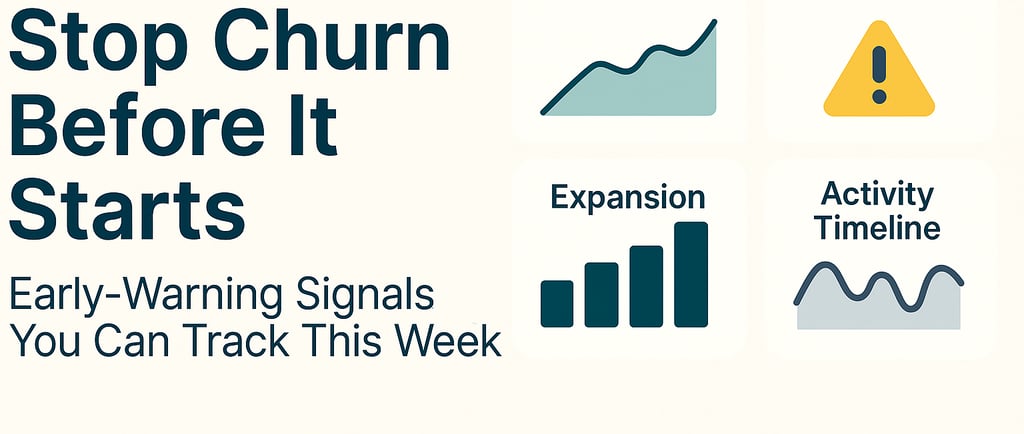Stop Churn Before It Starts: 7 Early‑Warning Signals You Can Track This Week
This post breaks down seven simple, actionable early-warning signals that can help you spot churn risk before it becomes a revenue loss. Using the CLX framework, it shows how to connect usage, support, billing, and engagement data to targeted playbooks that protect GRR and grow NRR. It’s a practical guide for turning customer insights into proactive retention moves that pay off quickly.
Ernie Maldonado
8/9/20252 min read


If churn feels “sudden,” it’s because the early signals were scattered across systems—support, billing, product usage, and the humans who talk to customers. CLX pulls those signals together so you can act before revenue walks out the door.
Below are seven practical, low‑lift signals you can start tracking this week. None require a full platform rebuild; they just need a consistent way to capture, review, and trigger action.
Quiet logins (usage frequency drop)
Watch 14/30/60‑day login deltas by account and persona. A sustained 25–40% drop is rarely random—it’s a value gap. Pair the alert with a “re‑value” play: short call, fresh success plan, and an in‑product nudge pointing to the next best feature.
Seat shrink vs. seat swap
Downgrades get attention; quiet seat removals don’t. Track “seats removed per active seats” by week. If removals > additions for 3 weeks, run a “role reset” play: confirm who’s accountable, who’s blocked, and whether permissions or training are the bottleneck.
Support sentiment flip
Tickets happen; tone matters. Flag accounts with rising time‑to‑first‑response or repeat tickets on the same topic. Route to a “quality fix + value reminder” play: close the loop publicly in the ticket, then add one small win the user will feel this week.
Payment friction
Late or partial payments are retention smoke. Create a “friendly finance” play: quick outreach from CS (not collections), confirm value realization to date, and reduce friction (billing contact, PO requirement, auto‑pay setup).
Implementation drift
If milestones slip twice, the risk is not the date—it’s the story. Trigger a “reset the narrative” play: get to a mini‑go‑live that visibly delivers value, even if it’s narrow. Publish a 3‑bullet success recap to re‑anchor the sponsor.
Executive silence
When your champion ghost‑rides the deal, pull in the economic buyer. Use a “1‑page ROI recap” play: baseline, what improved, what’s next 90 days. Ask for one metric the exec actually cares about and promise a weekly line chart.
Advocacy stall
Healthy accounts produce references, reviews, or referrals. If that slows, expansion usually follows suit. Run an “advocacy tune‑up” play: capture a tiny proof (Loom clip, quote, KPI), then invite them to a peer roundtable or early‑access program.
How we wire this (the CLX way)
Data: We pipe usage, support, billing, and notes into a simple health model—weighted and explained.
Plays: Each signal maps to a modular playbook with owners, steps, and time‑boxed outcomes.
Automation: Triggers fire cases/opportunities in Salesforce, and we measure the lift vs. baseline.
Proof: Quarterly, we show the delta in GRR/NRR tied to specific plays—so you can double down on what pays.
Want us to score your signals and stand up 3 “stop‑churn” plays in 30 days? Book a free CLX audit and we’ll show you where the revenue is hiding.
ELM Partners uses Collaborative Intelligence to help businesses protect and grow their recurring revenue.
© 2025 ELM Partners LLC. All Rights Reserved.
Navigation
Contact Us
info@elmpartners.us
954-740-1818
Ready to Grow?


